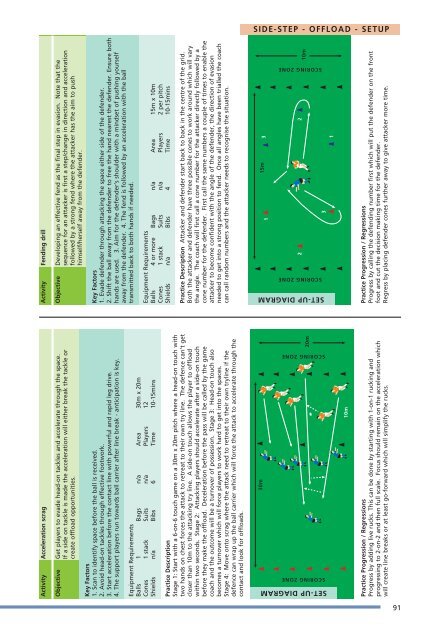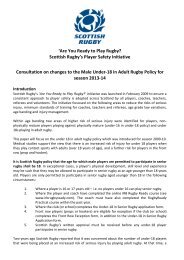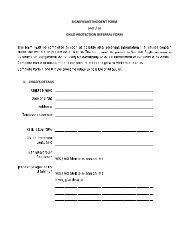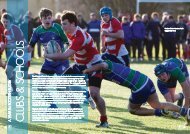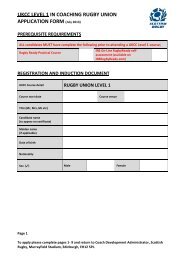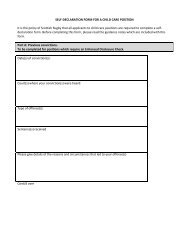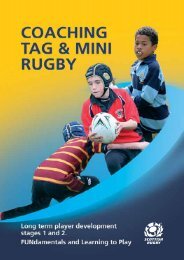LTPDst3cover.qxd (Page 1) - Scottish Rugby Union
LTPDst3cover.qxd (Page 1) - Scottish Rugby Union
LTPDst3cover.qxd (Page 1) - Scottish Rugby Union
- No tags were found...
You also want an ePaper? Increase the reach of your titles
YUMPU automatically turns print PDFs into web optimized ePapers that Google loves.
SIDE-STEP - OFFLOAD - SETUP30m20mSET-UP DIAGRAMSCORING ZONESCORING ZONE10m15m13223110mSET-UP DIAGRAMSCORING ZONESCORING ZONEActivity Acceleration scragObjective Get players to evade head-on tackles and accelerate through the space.If a side on tackle is made the acceleration will either break the tackle orcreate offload opportunities.Key Factors1. Scan to identify space before the ball is received.2. Avoid head-on tackles through effective footwork.3. Start acceleration before the contact line with powerful and rapid leg drive.4. The support players run towards ball carrier after line break - anticipation is key.Equipment RequirementsBalls 1 Bags n/a Area 30m x 20mCones 1 stack Suits n/a Players 12Shields n/a Bibs 6 Time 10-15minsPractice DescriptionStage 1: Start with a 6-on-6 touch game on a 30m x 20m pitch where a head-on touch withtwo hands on chest forces the attack to retreat to their own try line. The defence can’t getcloser than 10m to the attacking try line. A side-on touch allows the player to offloadwithin two seconds. Stage 2: Attacking players should accelerate after a side-on touchbefore they make the offload. Deceleration before the pass will be called by the gamecoach and the outcome will be a turnover of possession. Stage 3: Head-on touch alsobecomes a turnover which will force players to work hard to get into the spaces.Stage 4: Move onto scrag where the attack need to retreat to their own tryline if thedefence can wrap up the ball carrier which will force the attack to accelerate through thecontact and look for offloads.Practice Progression / RegressionsProgress by adding live rucks. This can be done by starting with 1-on-1 rucking andprogressing to 2-on-2 and then full scale. Focus should remain on the acceleration whichwill create line breaks or at least go-forward which will simplify the rucks.Activity Fending drillObjective Developing an effective fend as the final step in evasion. Note that thesequence for an attacker is first a step/change in direction and accelerationfollowed by a strong fend where the attacker has the aim to pushhimself/herself away from the defender.Key Factors1. Evade defender through attacking the space either side of the defender.2. Shift the ball away from the defender to free the hand nearest the defender. Ensure bothhands are used. 3. Aim for the defender’s shoulder with a mindset of pushing yourselfaway from the defender. 4. The fend is followed by an acceleration with the balltransmitted back to both hands if needed.Equipment RequirementsBalls 4 or more Bags n/a Area 15m x 10mCones 1 stack Suits n/a Players 2 per pitchShields n/a Bibs 4 Time 10-15minsPractice Description Attacker and defender start back to back in the centre of the grid.Both the attacker and defender have three possible cones to work around which will varythe angle. The coach will first call a cone number for the attacker directly followed by acone number for the defender. First call the same numbers a couple of times to enable theattacker to become confident with the angle of the defender, the direction of evasionneeded to get into a strong position to fend. Once all angles have been trialled the coachcan call random numbers and the attacker needs to recognise the situation.Practice Progression / RegressionsProgress by calling the defending number first which will put the defender on the frontfoot and cut the decision making time for the defender.Regress by placing defender cones further away to give attacker more time.91


